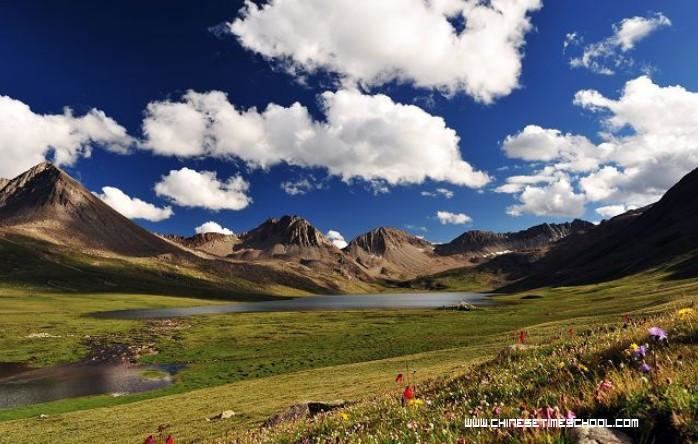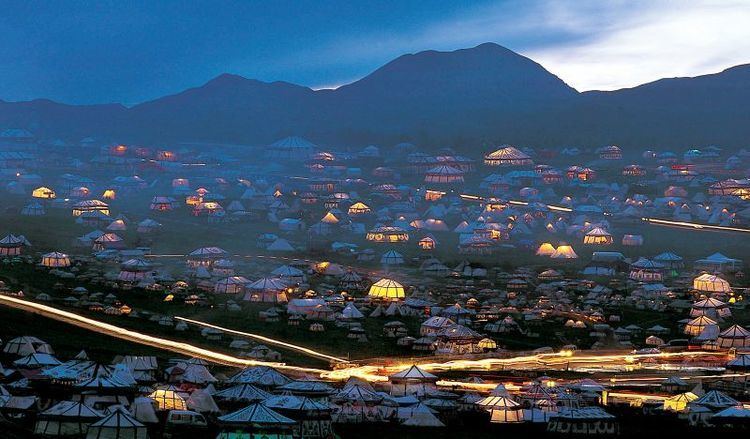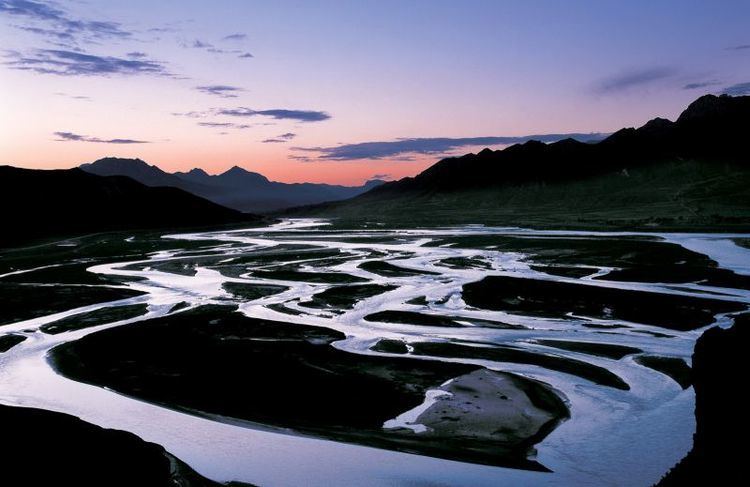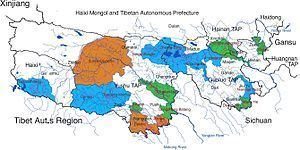Traditional Chinese 三江源國家級自然保護區 Traditional Chinese 三江源自然保護區 | Simplified Chinese 三江源国家级自然保护区 | |
 | ||
Literal meaning Three Rivers National Nature Reserve Hanyu Pinyin IPA [sántɕjáŋɥɛ̌n kwǒtɕjátɕǐ tsɹ̩̂ɻǎnpàuxûtɕʰý] | ||
The Sanjiangyuan National Nature Reserve (SNNR) also referred to as the Sanjiangyuan Nature Reserve or the Three Rivers Nature Reserve, is the area of the Tibetan Plateau in Qinghai province, China which contains the headwaters of the Yellow River, the Yangtze River, and the Mekong River. The SNNR was established to protect the headwaters of these three rivers. The reserve consists of 18 subareas, each containing three zones which are managed with differing degrees of strictness.
Contents

Along with wetland and waters protection, other ecological values, such as grassland, forest, and wildlife enhancement, have also been presented as goals. To advance the goals of the SNNR uncontrolled or poorly managed mining, logging, hunting, and grazing have been curtailed. Foreign and other mining firms have replaced the uncontrolled miners, trees have been planted, and measures have been taken to protect endangered species. To protect the grasslands, pastoralists are not permitted to graze their animals in designated ‘core zones’ (see below), and grazing is supervised elsewhere in the SNNR. In addition, residents have been resettled from core zones and other grassland areas of the SNNR, and rangeland has been fenced and is in the process of being privatized throughout the Sanjiangyuan Area.

Sanjiangyuan Area

The Sanjiangyuan Area (Chinese: 三江源地区; pinyin: Sānjiāngyuán Dìqū) covers the southern and eastern parts of Qinghai and has an area of about 363,000 km2, 50.4% of Qinghai. Included in it wholly or partially are 18 counties of the four Tibetan Autonomous Prefectures Yushu, Guoluo, Hainan, and Haungnan, and Haixi Mongol and Tibetan Autonomous Prefecture. The Sanjiangyuan Area’s population is about 600,000, 90% of which are Tibetan. 70% of the Sanjiangyuan Area’s population are considered to be ‘impoverished’, with the average income of about 2000 RMB (roughly $300) per person/year. Since animal husbandry is the primary source of income, and many people are nomadic, this figure does not reflect the actual standard of living in a largely non-cash economy. The Sanjiangyuan Area in general has no special legal status, and the term is used to indicate the region in which the three rivers arise, and the SNNR exists.
The Sanjiangyuan National Nature Reserve (SNNR) is a subarea of the Sanjiangyuan Area which covers an area of about 152,300 km2, 21% of Qinghai, 42% of the Sanjiangyuan Area. It is larger than England and Wales combined. About 200,000 people traditionally live within the area covered by the SNNR. Since the government has been resettling people residing in the Sanjiangyuan Area, with over 60,000 resettled so far, and plans to resettle all nomads in Qinghai by 2011, it is unclear how current the figure of 200,000 is. The State Forestry Administration and the Qinghai government legally established the SNNR in May, 2000. Its Management Bureau was founded September, 2001, and the SNNR obtained State-level (national) status January, 2003. The Management Bureau is in Xining, and is under the Qinghai Forest Bureau. Mr. Wang Zhibao, Director of the State Forest Administration, has said the goals of the nature reserve protect the Qinghai-Tibet Plateau ecosystem, with a focus on alpine swamp meadow and the natural habitat of wildlife in the Sanjiangyuan Area.

The SNNR consists of 18 subareas. These are of three types: wetland conservation (8 subareas), wildlife conservation (3 subareas), and shrubland or forest conservation (7 subareas). Each SNNR subarea has three zones: a core zone; a buffer zone; a multiple-use experimental zone.

The core zone is strictly managed with no grazing and has measures to protect endangered species. All development and use are prohibited. It is a ‘no man’s zone’, with all its residents resettled elsewhere.
The buffer zone promotes conservation but allows limited and rotational grazing. Residents from degraded are being resettled.
The multiple-use experimental zones may also be used for scientific investigations, eco-tourism, and other green industries. Residents from degraded areas are being resettled.
The predecessors to the zones on the SNNR map may be grazing zones which were part of the tuimu huancao, ‘converting pastures to grasslands’ program, which got its start in 2000. In this program there were three types of zones to address the problem of degraded pastures: zones in which grazing was permanently banned, zones in which grazing was to be banned for typically three to ten years, and zones which were seasonally closed to grazing or allowed seasonal rotational grazing. The implementation of four kinds of zones in Yushu and Guoluo prefectures also seem to provide a precedent, if these are not the SNNR map’s zones themselves described differently. The first two of these zones correspond to what is referred to on the SNNR map as the ‘core zone’, the third to the ‘buffer zone’, and the fourth to the ‘experimental zone’. In the third (i.e. buffer) zone there was to be a reduction in grazing or a ban on grazing for five or ten years., and in the fourth (i.e. experimental) zone there was to be rotational grazing to capacity.
Since the government also has a poverty reduction and a major project (e.g. dams) resettlement program, and plans to resettle all nomads by 2011, residents from the buffer and the experimental zones may be resettled under these programs rather than the ecological resettlement program.
The absolute and relative sizes, and the populations before resettlement, of the zones are:
The boundaries and characters of the zones are likely open to negotiation. For example, the Canadian mining company Inter-Citic’s Dachang gold prospect is in either a buffer or experimental zone (or both).
In addition, only the 3 functional subareas of the SNNR, those with protection stations, have definite boundaries. The other 15 subareas are more a plan for their final delineation. The three functional subareas are A'nimaqin, Suojia-Qumahe (2 stations,one in each Qumahe and Suojia), and Tongtian He. As our information is several years old, more subareas may now have protection stations and definite boundaries.
Townships affected
The SNNR is entirely in Qinghai. The following table lists the 71 townships which are wholly or partially in the SNNR.
Conservation subareas
This table lists the names of the 18 conservation subareas and the counties they wholly or partially occupy.
Birds
Tibetan snowcock, Tibetan partridge, mute swan, greylag goose, bar-headed goose, ruddy shelduck, mallard, spot-billed duck, common teal, common pochard, common merganser, hoopoe, Pacific swift, little owl, hill pigeon, red collared dove, black-necked crane, Tibetan sandgrouse, Chinese monal, common redshank, green sandpiper, common sandpiper, ibisbill, little ringed plover, lesser sand plover, Pallas's gull, brown-headed gull, common tern, black kite, bearded vulture, Himalayan vulture, cinereous vulture, common buzzard, upland buzzard, steppe eagle, golden eagle, greater spotted eagle, eastern imperial eagle, Pallas fish eagle, common kestrel, merlin, saker falcon, peregrine falcon, great crested grebe, little egret, grey heron, black stork, ground tit, red-billed chough, common raven, Sichuan jay, white-throated dipper, black redstart, Hodgson's redstart, Daurian redstart, white-winged redstart, white-capped water redstart, common starling, wallcreeper, sand martin, Asian house martin, white-browed tit warbler, Tibetan lark, Oriental skylark, horned lark, house sparrow, Eurasian tree sparrow, white-winged snowfinch, Tibetan snowfinch, white-rumped snowfinch, rufous-necked snowfinch, plain-backed snowfinch, white wagtail, citrine wagtail, Richard's pipit, alpine accentor, robin accentor, brown accentor, twite, Brandt's mountain finch, common rosefinch, streaked rosefinch, great rosefinch, red-fronted rosefinch.
Mammals
Wolf, red fox, sand fox, brown bear, otter, alpine weasel, steppe polecat, Eurasian badger, Pallas's cat, common leopard, lynx, snow leopard, wild ass, alpine musk deer, wild yak, Tibetan antelope, Tibetan gazelle, white-lipped deer, blue sheep, Tibetan argali, Himalayan marmot, Tibetan hamster, black-lipped pika, large-eared pika, Glover's pika, woolly hare.
